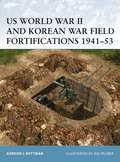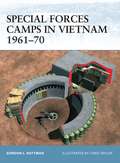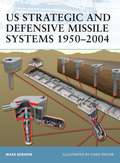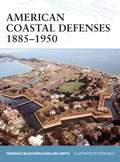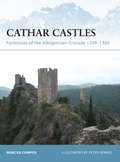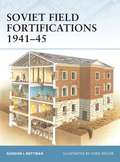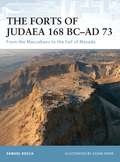- Table View
- List View
Afghanistan Cave Complexes 1979–2004: Mountain strongholds of the Mujahideen, Taliban & Al Qaeda (Fortress)
by Ian Palmer Mir BahmanyarFollowing the Soviet invasion in 1979, the Mujahideen defenders of Afghanistan developed and reinforced many natural cave systems to use as supply bases and defensive positions. The Taliban and Al Qaeda further strengthened these positions in the 1990s. Following the events of September 11, 2001, these cave systems have once more come to prominence and sites such as Tora Bora and Zhawar Kili have featured in news headlines around the world. This title provides an analysis of these caves and underground systems, and discusses the U.S.-led Coalition's tactical approach to dislodging the enemy from these fortified positions.
French Fortresses in North America 1535–1763: Québec, Montréal, Louisbourg and New Orleans (Fortress)
by René Chartrand Donato SpedaliereFollowing the discovery of America by Columbus in 1492, European colonists brought their system of fortification to the New World in an attempt to ensure their safety and consolidate their conquests. French and British explorers came later to North America, and thus the establishment of their sizeable settlements only got under way during the 17th century. The inhabitants of New France built elaborate fortifications to protect their towns and cities. This book provides a detailed examination of the defenses of four of them: Québec, Montréal and Louisbourg in Canada, and New Orleans in Louisiana.
US World War II and Korean War Field Fortifications 1941–53 (Fortress)
by Gordon L. Rottman Ian PalmerThe US Army and Marine Corps in World War II considered themselves highly mobile, offensive forces. Their mobile-warfare doctrine envisioned field fortifications and obstacles as temporary in nature. As a result, their design was simple and made use of local materials, and they could be constructed comparatively quickly, whilst still providing adequate protection. By the time of the Korean War, only minor changes had been made to field fortification construction and layout, and to small-unit organization, weapons, and tactics. This title addresses field fortifications built by US infantrymen during World War II and in Korea, and covers rifle-platoon positions, trenches, crew-served weapon positions, bunkers, dugouts, shelters, observation posts and anti-tank obstacles.
Fort Eben Emael: The key to Hitler’s victory in the West (Fortress)
by Hugh Johnson Simon DunstanAt the outbreak of World War II, Fort Eben Emael in Belgium was the strongest fortress in the world, and it lay exactly across the German invasion route of Belgium and France. The fort's elimination was essential for the success of Hitler's invasion of the West. Deemed impregnable to conventional attack, Hitler himself suggested the means for its capture with the first glider-borne assault in military history. On 10 May 1940, ten gliders carrying just 77 paratroopers landed on top of the fort. Using top-secret hollow-charge weapons for the first time in warfare, the assault pioneers of Sturmgruppe Granit subdued Fort Eben Emael within just 30 minutes, and the fortress surrendered within 30 hours. It remains one of the greatest raids in the annals of Special Forces.
Special Forces Camps in Vietnam 1961–70 (Fortress)
by Gordon L. Rottman Chris TaylorIn 1961 US Special Forces units began entering remote areas of Vietnam dominated by the Viet Cong. Their task was to organize local defense and strike forces aimed at stopping the enemy from gaining further control of such areas. The Green Berets set up fortified camps from which indigenous troops defended local villages and attacked and harassed the enemy. How these camps were constructed, developed, and defended is documented here for the first time. This book also covers the weapons, barriers, and obstacles used in these camps, providing specific examples of camp design, and details how they withstood the test of battle against a determined and resourceful enemy.
Japanese Fortified Temples and Monasteries AD 710–1602 (Fortress #34)
by Peter Dennis Stephen TurnbullFrom the 10th century onwards the great Japanese monastic foundations of Nara and Mount Hiei maintained large armies of warlike monks. The tempestuous political rivalries that developed between the different orders of monks and religiously inspired laymen ensured that their temples and monasteries had to be securely sited and robustly defended. This books recreates these enormous fortified monasteries and temples, tracing their development from the 10th century through to the Sengoku Jidai period and the rise of the power of the shogunate under Tokugawa Ieyasu.
US Strategic and Defensive Missile Systems 1950–2004 (Fortress)
by Chris Taylor Mark BerhowFor 40 years following the end of World War II, the Western democratic governments and the Eastern Bloc Communist powers were locked in the ideological, political, and economic struggle of the Cold War. The United States and the Soviet Union developed missile systems capable of delivering conventional and nuclear explosives against enemy massed bomber formations in the air, and of delivering retaliatory nuclear payloads against ground targets located on distant continents. The missile systems played both a defensive role, and a potential offensive role, which was parlayed to the public as deterrence against attack by the rival bloc. This title provides a detailed overview of the fixed-launch-site strategic missile systems of the United States.
D-Day Fortifications in Normandy (Fortress)
by Hugh Johnson Steven J. ZalogaGerman defenses along the Normandy beaches were part of the larger Atlantic Wall fortifications designed to defend Fortress Europe. When Field Marshal Erwin Rommel took command of the invasion front in late 1943, he began a program to enhance fortifications along the Normandy coast as he believed that any Allied assault had to be stopped on the invasion beaches themselves. His most important contribution to the defenses was an extensive program of improvised beach obstructions to complicate any landing attempt. This book analyses these fortifications and describes how the Allied forces overcame them on the morning of June 6, 1944.
American Civil War Fortifications: Land and Field Fortifications (Fortress #2)
by Peter Dennis Ron FieldThe American Civil War saw a massive development in the use of field fortifications, the result of the practical application of antebellum West-Point teaching, and the deadly impact of rifled infantry weapons and artillery. Both the Federal and Confederate armies began to develop far more sophisticated systems of field fortification, and the larger field works and fortifications surrounding Washington, DC and Richmond, VA were redesigned and rebuilt several times. This volume explores the role of land and field fortifications in the eastern and overland campaigns of the Civil War between 1861 and 1865. Particular attention is devoted to the nine-month siege of Petersburg, where daily life within the redoubts, lunettes, redans, bomb-proofs, trenches and rifle pits is vividly described.
The Channel Islands 1941–45: Hitler's impregnable fortress (Fortress)
by Chris Taylor Charles StephensonFollowing the fall of France and the surrender of Paris on 14 June 1940, the British Government announced that the Channel Islands had no strategic importance and would not be defended. The Germans occupied the islands from the end of June onwards and remained in control until the end of the war. On 10 October 1941 Hitler announced his intention to 'convert them into an impregnable fortress', and the islands formed the most heavily fortified and defended section of the entire Atlantic Wall. This book describes the design, construction and manning of these defensive positions, as well as considering more widely the occupation of the Channel Islands by the Germans.
The Vauban Fortifications of France (Fortress)
by Peter Dennis Paddy GriffithVauban was the foremost military engineer of France, not only during his lifetime, but also throughout the 18th century when his legacy and methods remained in place almost unchanged. Indeed, his expertise and experience in the construction, defence, and attack of fortresses is unrivalled by any of his contemporaries, of any nationality. In all three of those fields he was a significant innovator and prolific exponent, having planned approximately 160 major defensive projects and directed over 50 sieges. This book provides not only a modern listing of his varied interventions and their fates, but also a wide-ranging discussion of just how and why they pushed forward the international boundaries of the arts of fortification.
American Coastal Defenses 1885–1950 (Fortress)
by Peter Bull Terrance McGovern Bolling SmithIn the late-19th century, with the advances in technology and the increase in America's economic stature, a new round of fortification building began in the United States and its overseas territories. Locations such as Portland, Boston, New York, Baltimore, Charlestown, Savannah, Key West, Los Angeles and San Francisco were all extensively fortified. This book provides a concise introduction to the design, development and purpose of American coastal defenses in the "modern" era (1885–1950), a period defined by the use of concrete, steel, and powerful breech-loading rifles. It covers the emplacements, weaponry, equipment, and people that defended their country in times of great change and uncertainty.
Castles and Tower Houses of the Scottish Clans 1450–1650 (Fortress)
by Stuart Reid Graham TurnerWith the exception of the key royal sites, such as Stirling and Edinburgh, few Scottish castles were located at strategic points, or were intended to house garrisons required to defend or subjugate towns. Instead they were primarily fortified dwelling houses, erected in an environment of weak Royal authority and endemic feuding between rival clans and groups, in both Highland and Lowland areas. Although some enceinte castles were developed during the 16th and 17th centuries, most defensive construction focused on the tower house, a distinctive vernacular style of Scottish fortification. This book examines the design, development, and purpose of these quintessentially Scottish buildings, and also covers larger sites such as Urquhart and Blackness.
Fortifications of the Incas: 1200–1531 (Fortress)
by J. E. Kaufmann Adam Hook H. W. KaufmannThe greatest period of Inca expansion occured during the reigns of Pachacuti (1438–71), Tupa Inca (1471–93), and Huayna Capac (1493–1527). From the mountain stronghold of Cuzco, they subjugated the surrounding kingdoms and territories, absorbing their civilizations and their peoples. By 1525, they dominated much of the west of the continent, relying on fortified strongholds, an extensive system of roads and bridges, and obligatory military service to control local populations. This title takes a detailed look at the development of Incan fortification techniques, and examines how they came to be overrun by the Spanish conquistadors.
The Fortifications of Gibraltar 1068–1945 (Fortress)
by Adam Hook Darren Fa Clive FinlaysonGibraltar, located at the meeting points of Europe and Africa, preserves within its fortifications a rich testament to human conflict spanning 600 years. In 1068 the ruling Spanish Muslims built a large fort there. Between 1309 and 1374 Gibraltar underwent a period of intensive building and fortification, and following the Spanish reconquest of 1462 the inhabitants carried out further works. In 1704 the latest, uninterrupted period of British rule began. The 18th century saw three sieges including the most severe, known as the Great Siege, which lasted from 1779 to 1783. During World War II the 'Rock' served as a vital stop for supply convoys and naval staging base, complete with a veritable warren of secret tunnels. This book documents Gibraltar's rich history, and charts the development of these fascinating fortifications.
Defending Space: US Anti-Satellite Warfare and Space Weaponry (Fortress)
by Clayton Chun Chris TaylorThe United States has been developing space for many years, and satellites provide the US Military with an unparaleled advantage over its adversaries. Constellations of both military and civilian satellites provide protection and support for military operations; deliver ballistic missile early warning; supply reliable, secure and jam-proof communications; gather audio-visual intelligence; predict weather patterns; guide navigation; and deliver guided-weapons targeting, as well as a host of other missions. This book explores the design, development and usage of US military space systems, as well past and future threats to the systems. The current relevance of this topic to the international community as a whole is key, as space becomes the next, if only virtual, theater of warfare.
Cathar Castles: Fortresses of the Albigensian Crusade 1209–1300 (Fortress)
by Peter Dennis Marcus CowperDuring the early 13th century the north of what is now France went to war with the south in a bloody crusade aimed at destroying the heretical sect known as the Cathars. The conflict was characterized by vicious guerrilla actions and the besieging of the innumerable fortified sites that dotted the landscape of the south. Illustrated with full colour artwork and stunning photographs, this book describes the castles and fortifications of the Cathar period, examining their design, construction and the role that they played during the Albigensian Crusade.
The Great Wall of China 221 BC–AD 1644 (Fortress)
by Stephen Turnbull Steve NoonThe most famous example of fortification in the world, the Great Wall of China stretches for more than 6,000km across inhospitable terrain. Charting its development from its earliest origins in the 7th century BC through to the present day, this account reveals the true history of the wall, and explores the myths that surround it. Included are details of what it was like to live within the wall, how it was garrisoned and patrolled, and a discussion of how effective it was against attack. Through extensive examination of both ancient and modern sources, colour maps, artwork and photographs, this book illustrates why the wall is one of the great wonders of the world.
Crusader Castles in Cyprus, Greece and the Aegean 1191–1571 (Fortress)
by David Nicolle Adam HookThe castles built by the Crusaders, Hospitallers, Venetians and Genoese in Cyprus, Greece, the Aegean, and on the Black Sea served to defend against a complex array of constantly changing threats: Mamluks, Catalan mercenaries, Ottoman Turks, Byzantines, independent Islamic states, Timur-i-Lenk, and widespread piracy, to name but few. The resulting fortifications some inherited from conquered the territories of the former Byzantine empire, some built from scratch were very different to those found in the Middle East. This superbly illustrated book explores their design, development and fate in detail, documenting the rich architectural heritage of this region and its complex history.
Medieval Russian Fortresses AD 862–1480 (Fortress)
by Peter Dennis Konstantin S NossovAccording to Russian legend, in the year AD 862 the Slav tribes of what is now European Russia invited a number of Scandinavian princes to rule over them. However, on the death of these princes, Prince Oleg seized Kiev and united the Northern and Southern Russian territories, building extensive fortifications to protect its borders. The rise of feudalism in the 11th century lead to the development of individual fortified sites and the extended border defenses fell into disrepair. Consequently, Mongol hordes poured over the border introducing the siege warfare techniques of the East, heavily influencing the fortification styles thereafter. Using a wealth of archeological evidence and first-hand sources, Konstantin Nossov charts the history of the medieval Russian fortress from its early beginnings until the 14th century, paying special attention to the development of one of the most iconic fortifications in the world: the Kremlin.
Soviet Field Fortifications 1941–45 (Fortress)
by Gordon L. Rottman Chris TaylorFrom June 1941, the Soviets were forced to undertake large-scale defensive operations in the face of the overwhelming German blitzkrieg assault, operations which ran counter to their preference for highly mobile, offensive warfare. Lessons were quickly learned across a wide variety of terrain and climates, including the open steppes, dense forests, wooded swamps, cities, and in snow and ice, where the availability of construction materials differed greatly. The first to cover this topic in the English language and containing detailed information about the trenches, bunkers, observation posts and weapon positions, this book examines field fortifications built from local materials by infantrymen, as well as their use of mines, field camouflage techniques, and construction tools. It provides a first fascinating insight into Russian defensive attempts against the overwhelming might of the German Army.
The Atlantic Wall: France (Fortress #63)
by Hugh Johnson Steven J. Zaloga Chris Taylor Lee RayGermany's Atlantic Wall was the most ambitious military fortification program of World War II. With Germany's gradual loss of the strategic initiative to the Allies, in 1942 Hitler was forced to construct an impenetrable wall of fortifications along the Atlantic and Mediterranean coast. This book deals solely with the structures on the French coast, starting with the Pas-de-Calais and extending down to Spain. It features detailed illustrations and diagrams of the various sections of the Atlantic Wall and the role that they played, giving a thoughtful analysis of some of the most accessible fortifications of World War II.
The Castles of Edward I in Wales 1277–1307 (Fortress)
by Adam Hook Christopher GravettIn 1277 Edward I gathered a huge army and marched into Wales to subdue the rebel Welsh princes. A key part of his strategy was to erect a castle wherever his army rested. This title takes a detailed look at the design, development and principles of defence of these Welsh castles, documenting daily life within their walls and the historical events that took place around them. Focusing on key sites, it highlights the varied castle designs ranging from fortifications based on French models to the defences inspired by Constantinople, and is illustrated with eight pages of full-colour illustrations and cutaway artwork.
The Forts of Judaea 168 BC–AD 73: From the Maccabees to the Fall of Masada (Fortress)
by Samuel Rocca Adam HookThis book analyzes the fortifications of Hasmonaean and Herodian Judaea from the middle of the second century BC, when the Maccabees rebelled against their Seleucids overlords and established an independent state, until the end of the Jewish-Roman War in AD 73.
The Castles of Henry VIII (Fortress #66)
by Peter Harrington Brian DelfIn the last years of his reign Henry VIII needed a radically modern system of defence to protect England and its new Church. Anticipating a foreign onslaught from Catholic Europe after his split from Rome, Henry energetically began construction of more than 20 stone forts to protect England's major ports and estuaries. Aided by excellent illustrations, Peter Harrington explores the departure from artillery-vulnerable medieval castle designs, to the low, sturdy stone fortresses inspired by European ideas. He explains the scientific care taken to select sites for these castles, and the transition from medieval to modern in this last surge of English castle construction.


